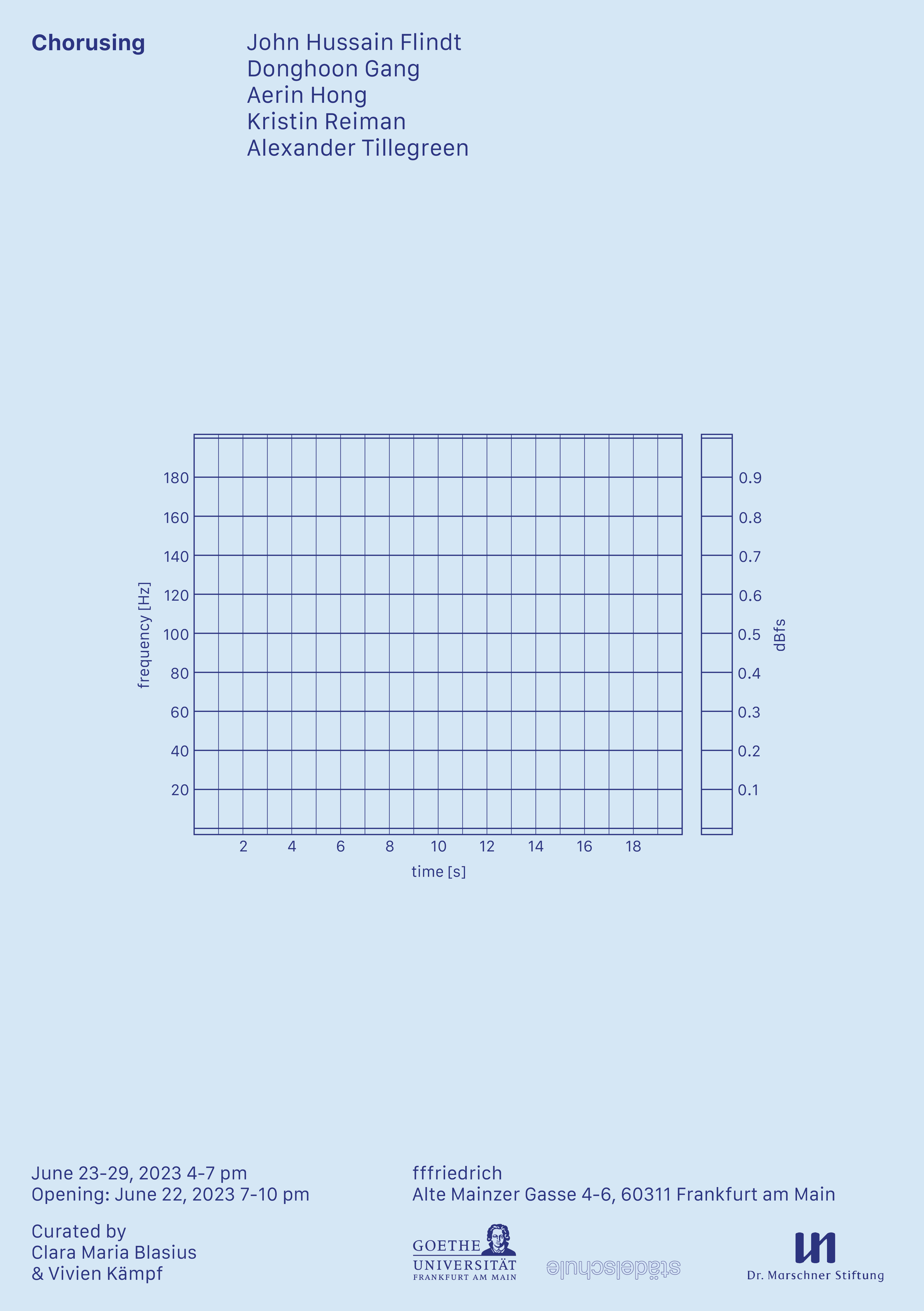Chorusing
With John Hussain Flindt, Donghoon Gang, Aerin Hong, Kristin Reiman & Alexander Tillegreen
Curated by Clara Maria Blasius & Vivien Kämpf
Light falling onto an object must be partially reflected, partially soaked up for it to appear as coloured. If the light were completely scattered, absorbed, or transmitted, it would instead be white, black, or transparent respectively. Certain wavelengths have to be swallowed—lost—in order for a specific physical colour to appear—to be gained.
Chorusing describes an audio effect that occurs when two or more sounds with very similar pitches coincide at the same time. This can emerge naturally in—the eponym—a choir, a string ensemble, or certain instruments, namely the piano or the organ. Minimal differences in pitch and timing among multiple musicians or vocalists result in the typical sound of rich and shimmering quality. Analogously, the digital imitation of this phenomenon is called the chorus effect. When recreated electronically, the effect is achieved by creating one or more copies of a signal sound, which are then added with a delay of about a dozen milliseconds. As this lies below the human echo threshold, the deferred duplicates are not discerned as such. While none of the individual tones are experienced as off-pitch or out of tune, the delayed layering renders the sound thicker, fuller, or more spacious.
To chorus also means: two or more persons utter something in unison or say similar things at the same time. Similar, not necessarily identical.
Figures of speech such as similes, metaphors, or analogies are some of the ways to enlarge and enhance language. Distinction through comparison, expression through embodiment. As perception is always shaped by previous experiences, knowledge, emotions, as well as various other factors, a thing is recognized as being identical with, alike to, or different from another. Consciously or unconsciously, similarity, comparability, or relatability are suggested, analogies are employed, in order to explain or simply apprehend.
Analogies between sound and space abound. The expression colour of noise draws parallels between colour shades and certain sound phenomena. Whilst the most widely known is the hissing sound of white noise, there are equivalents corresponding to other areas of the spectrum, among them pink and brown noise. Some of them have concrete definitions, while others are rather informally understood. A few of their spectral patterns are, in fact, incorrectly translated.
Some figures of speech are technically replacements. As in every transfer, disruptions are to be expected. Whether digital or analogue, whether verbal, non-verbal or paraverbal communication—the latter meaning a voice’s tone, pitch, and pacing, among other aspects—signals and signs are received, perceived, and (mis-)interpreted. From one tongue and timbre to the other, ear to ear, transmission or translation errors occur. In every fault, loss or interference lies a potential gain. A sound wave has to hit in order to be heard.
The works in “Chorusing” are located at different points within these relational webs of stimulation and simulation, articulation and association. Space and sound, speech and thought, body and mind. Each in their own way, they refer to imagined or real deviation, discrepancy, detuning, and dissonance that shape and enrich the perception of ourselves and our surroundings.
Text: Clara Maria Blasius
Videos of the works
Donghoon Gang Dry & Wet (dyptych)
Aerin Hong Private Lessons
Kristin Reimann No air is unmarked
Alexander Tillegreen Phantom Streams (5 movements)
 Chorusing, Installation view, Photo: Jakob Otter
Chorusing, Installation view, Photo: Jakob Otter John Hussain Flindt, left: synktrctrnscndc & th *prtl cmplx #8, 2021, right:
John Hussain Flindt, left: synktrctrnscndc & th *prtl cmplx #8, 2021, right:synktrctrnscndc & th *prtl cmplx #9, 2021, Photo: Jakob Otter
 Chorusing, Installation view, Photo: Jakob Otter
Chorusing, Installation view, Photo: Jakob Otter Chorusing, Installation view, Photo: Jakob Otter
Chorusing, Installation view, Photo: Jakob Otter Alexander Tillegreen, Wanderer, 2019, Photo: Jakob Otter
Alexander Tillegreen, Wanderer, 2019, Photo: Jakob Otter Chorusing, Installation view, Photo: Jakob Otter
Chorusing, Installation view, Photo: Jakob Otter
